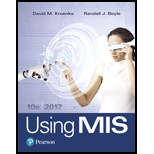
Concept explainers
Explanation of Solution
Levels of scope:
The three levels of scope are:
- Workgroup
- Enterprise
- Inter-enterprise
Workgroup processes:
Workgroup processes achieve goals of a particular department by implementing groupwork.
Example: Professors’ time table manager, subject manager, workload manager.
Enterprise processes:
Enterprise processes provide the organization to sustain longer and also it supports the activities performed in various departments.
Example: Students’ events manager.
Inter-enterprise processes:
Inter-enterprise processes provide two or more independent organization to sustain longer and also it supports the activities performed in various departments.
Example: Symposium manager
The three departmental information systems that share common data are: financial department, library department, and Administrator department. These all departments share common data like student’s name, age, department, enroll ID, etc.
Characteristics:
| Scope | Examples | Characteristics |
|
Workgroup | Timetable manager, subject manager and workload manager for the professors. | It contains 10 to 100 users. It is used by professors from the university. |
| Enterprise information system | Events manager for students | It contains 100 to 1000 users. It is used by students as well as professors. |
| Inter-enterprise information system | Symposium manager | It contains more than 1000 users. It is used by several universities. |
Want to see more full solutions like this?
Chapter 7 Solutions
Using MIS (10th Edition)
- show all the workarrow_forwardList down the strenghts and weaknesses of your team project for Capsim Simulation? Explan.arrow_forwardCapsim Team PowerPoint Presentations - Slide Title: Key LearningsWhat were the key learnings that you discovered as a team through your Capsim simulation?arrow_forward
- Write the SQL code that permits to implement the tables: Student and Transcript. NB: Add the constraints on the attributes – keys and other.arrow_forwardDraw an ERD that will involve the entity types: Professor, Student, Department and Course. Be sure to add relationship types, key attributes, attributes and multiplicity on the ERD.arrow_forwardDraw an ERD that represents a book in a library system. Be sure to add relationship types, key attributes, attributes and multiplicity on the ERD.arrow_forward
 Principles of Information Systems (MindTap Course...Computer ScienceISBN:9781285867168Author:Ralph Stair, George ReynoldsPublisher:Cengage Learning
Principles of Information Systems (MindTap Course...Computer ScienceISBN:9781285867168Author:Ralph Stair, George ReynoldsPublisher:Cengage Learning Management Of Information SecurityComputer ScienceISBN:9781337405713Author:WHITMAN, Michael.Publisher:Cengage Learning,
Management Of Information SecurityComputer ScienceISBN:9781337405713Author:WHITMAN, Michael.Publisher:Cengage Learning, Principles of Information Systems (MindTap Course...Computer ScienceISBN:9781305971776Author:Ralph Stair, George ReynoldsPublisher:Cengage Learning
Principles of Information Systems (MindTap Course...Computer ScienceISBN:9781305971776Author:Ralph Stair, George ReynoldsPublisher:Cengage Learning Database Systems: Design, Implementation, & Manag...Computer ScienceISBN:9781305627482Author:Carlos Coronel, Steven MorrisPublisher:Cengage Learning
Database Systems: Design, Implementation, & Manag...Computer ScienceISBN:9781305627482Author:Carlos Coronel, Steven MorrisPublisher:Cengage Learning Database Systems: Design, Implementation, & Manag...Computer ScienceISBN:9781285196145Author:Steven, Steven Morris, Carlos Coronel, Carlos, Coronel, Carlos; Morris, Carlos Coronel and Steven Morris, Carlos Coronel; Steven Morris, Steven Morris; Carlos CoronelPublisher:Cengage Learning
Database Systems: Design, Implementation, & Manag...Computer ScienceISBN:9781285196145Author:Steven, Steven Morris, Carlos Coronel, Carlos, Coronel, Carlos; Morris, Carlos Coronel and Steven Morris, Carlos Coronel; Steven Morris, Steven Morris; Carlos CoronelPublisher:Cengage Learning





